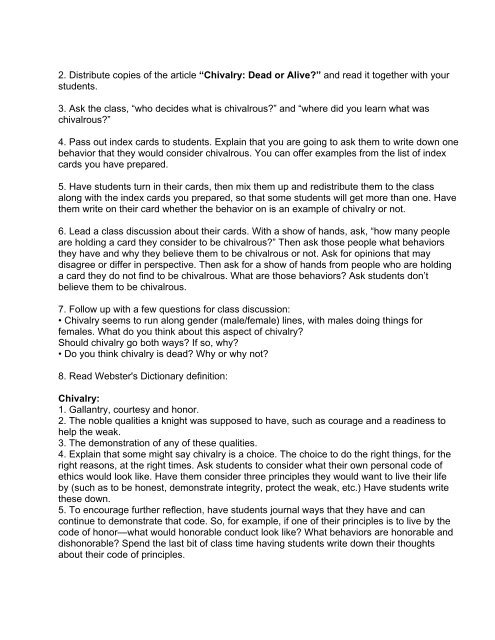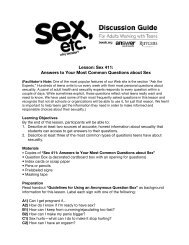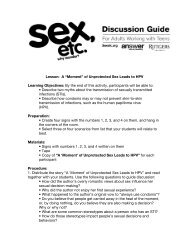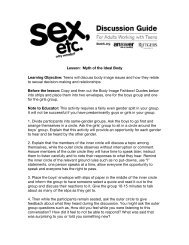Lesson: Chivalry: Dead or Alive? Learning Objectives: By ... - Answer
Lesson: Chivalry: Dead or Alive? Learning Objectives: By ... - Answer
Lesson: Chivalry: Dead or Alive? Learning Objectives: By ... - Answer
Create successful ePaper yourself
Turn your PDF publications into a flip-book with our unique Google optimized e-Paper software.
2. Distribute copies of the article “<strong>Chivalry</strong>: <strong>Dead</strong> <strong>or</strong> <strong>Alive</strong>?” and read it together with your<br />
students.<br />
3. Ask the class, “who decides what is chivalrous?” and “where did you learn what was<br />
chivalrous?”<br />
4. Pass out index cards to students. Explain that you are going to ask them to write down one<br />
behavi<strong>or</strong> that they would consider chivalrous. You can offer examples from the list of index<br />
cards you have prepared.<br />
5. Have students turn in their cards, then mix them up and redistribute them to the class<br />
along with the index cards you prepared, so that some students will get m<strong>or</strong>e than one. Have<br />
them write on their card whether the behavi<strong>or</strong> on is an example of chivalry <strong>or</strong> not.<br />
6. Lead a class discussion about their cards. With a show of hands, ask, “how many people<br />
are holding a card they consider to be chivalrous?” Then ask those people what behavi<strong>or</strong>s<br />
they have and why they believe them to be chivalrous <strong>or</strong> not. Ask f<strong>or</strong> opinions that may<br />
disagree <strong>or</strong> differ in perspective. Then ask f<strong>or</strong> a show of hands from people who are holding<br />
a card they do not find to be chivalrous. What are those behavi<strong>or</strong>s? Ask students don’t<br />
believe them to be chivalrous.<br />
7. Follow up with a few questions f<strong>or</strong> class discussion:<br />
• <strong>Chivalry</strong> seems to run along gender (male/female) lines, with males doing things f<strong>or</strong><br />
females. What do you think about this aspect of chivalry?<br />
Should chivalry go both ways? If so, why?<br />
• Do you think chivalry is dead? Why <strong>or</strong> why not?<br />
8. Read Webster's Dictionary definition:<br />
<strong>Chivalry</strong>:<br />
1. Gallantry, courtesy and hon<strong>or</strong>.<br />
2. The noble qualities a knight was supposed to have, such as courage and a readiness to<br />
help the weak.<br />
3. The demonstration of any of these qualities.<br />
4. Explain that some might say chivalry is a choice. The choice to do the right things, f<strong>or</strong> the<br />
right reasons, at the right times. Ask students to consider what their own personal code of<br />
ethics would look like. Have them consider three principles they would want to live their life<br />
by (such as to be honest, demonstrate integrity, protect the weak, etc.) Have students write<br />
these down.<br />
5. To encourage further reflection, have students journal ways that they have and can<br />
continue to demonstrate that code. So, f<strong>or</strong> example, if one of their principles is to live by the<br />
code of hon<strong>or</strong>—what would hon<strong>or</strong>able conduct look like? What behavi<strong>or</strong>s are hon<strong>or</strong>able and<br />
dishon<strong>or</strong>able? Spend the last bit of class time having students write down their thoughts<br />
about their code of principles.
















